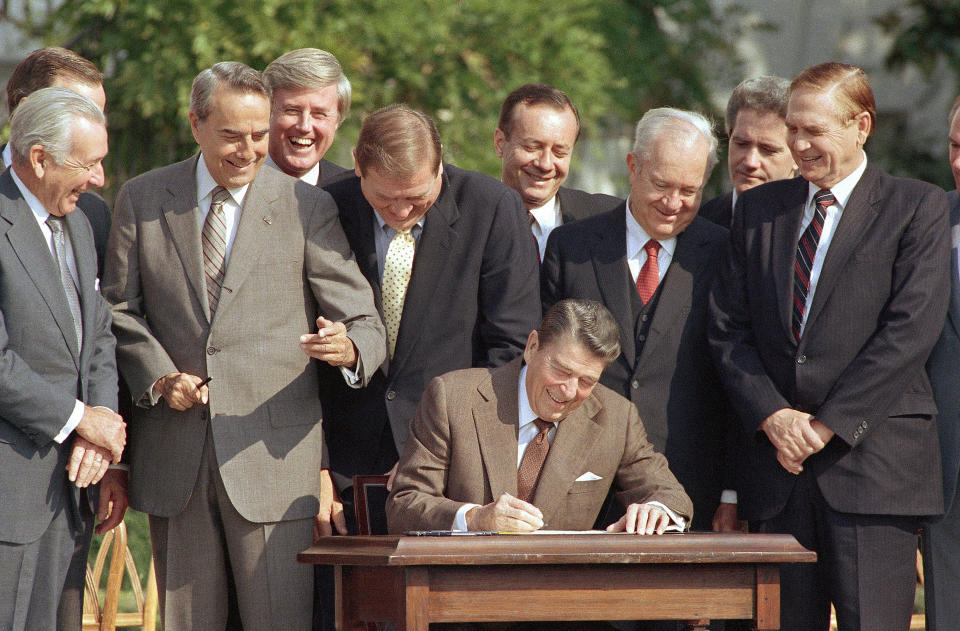The lessons Trump's 'Red Team' needs to learn about passing tax reform

Remember the Republican Party’s crusade to repeal Obamacare? You know, the one that featured prominently in pretty much every GOP campaign ad between 2010 and 2016 — and then consumed the whole of President Trump’s legislative agenda for first seven months of the year before collapsing in chaos right before lawmakers left town for August recess?
Never mind all that. Next month, Republicans plan to move on to tax reform—and they swear that this time, everything will be different.
As Bloomberg Politics reported Wednesday, the White House is now seeking to advance Trump’s signature tax code overhaul and “avoid the missteps that doomed the effort to repeal Obamacare” by toning down president’s “improvisational approach” in favor of a more “tightly orchestrated process.”
The centerpiece of this strategy, according to the four anonymous White House officials who spoke to Bloomberg, is a weekly meeting of aides and advisors who have taken to calling themselves “The Red Team.” The name — an homage to the similar groups that formed during George W. Bush’s big legislative battles — is meant to convey “urgency and close coordination,” officials said.
“There is a concentration of the mind,” said Grover Norquist, president of Americans for Tax Reform. “They in the White House have done much more focused job of messaging this issue than earlier issues.”
But as Trump’s so-called Red Team schemes about messaging, its members would be wise to remember how rarely tax reform has succeeded in the past — and try to learn some lessons from the few times it has.
The last time Congress reformed the federal tax code was more than three decades ago. The story of the Tax Reform Act of 1986 is long and convoluted. But the one thing everyone seems to agree on — the key to the bill’s eventual success — is that it was a bipartisan effort.
Tax reform typically involves two related tweaks designed to simplify and stabilize the tax code: Cutting rates to provide relief to individuals and corporations, and broadening the base — i.e. taxing income that is currently untaxed (which is usually accomplished by eliminating various deductions and shelters). The reason tax reform is rarely enacted is that pretty much everyone — whether you’re an ordinary taxpayer or a powerful special interest — has a deduction they’d rather not lose: mortgage interest, charitable giving, etc. Taking away stuff that people like is generally considered bad politics.
The way Republicans and Democrats typically avoid shouldering the blame for the less popular aspects of tax reform is simple: They hold hands and jump together. In his 1984 State of the Union address, President Ronald Reagan announced that he had directed his treasury secretary to develop a plan “to simplify the entire tax code so all taxpayers, big and small, are treated more fairly.” Democratic Sens. Bill Bradley of New Jersey and Dick Gephardt of Missouri were already touting their own proposal to reduce rates and eliminate preferences. When the Treasury finally unveiled its framework in late November, Democrats didn’t bolt; instead, two pivotal House leaders — Speaker Tip O’Neill and Dan Rostenkowski, chairman of the Ways and Means Committee, quickly decided that “they should join [Reagan] and try to win some credit for the Democratic Party,” as the New York Times later put it.
What followed was one of the all-time-great demonstrations of across-the-aisle sausage-making. Rostenkowski declared tax reform his “mission in 1985,” then endorsed the principles of Reagan’s proposal in a primetime speech. Reagan undertook an extraordinary trip to Capitol Hill to personally lobby reluctant Republicans, flipping 35 GOP votes in the process. Sen. Bob Packwood of Oregon, chairman of the Finance Committee, assembled a team of seven senators — four Republicans and three Democrats — to secretly craft an 11th-hour tax package, then convinced them to band together against any changes to the proposal.
The Senate eventually approved Packwood’s bill by a staggering 97-to-3 margin; to hammer out a final version, Packwood and Rostenkowski engaged in five days of nonstop man-to-man negotiations. In the end, Reagan signed the bill into law on the South Lawn of the White House as rows of instrumental Republicans and Democrats beamed behind him.

But that, of course, was then. In 1986, Republicans controlled only the White House and the Senate; the House was firmly in Democratic hands. Today, the GOP has total control in Washington — and as a result, its leaders don’t seem to think bipartisanship is necessary anymore.
“I don’t think this is going to be 1986, when you had a bipartisan effort to scrub the code,” Senate Majority Leader Mitch McConnell told reporters earlier this month.
The president appears to be equally unenthusiastic about pulling a Reagan.
“One of the worst ideas in recent history,” Trump wrote about the bipartisan, broadening-the-base aspects of the 1986 reform law.
Instead, the Senate GOP’s current scheme is to use the 51-vote budget reconciliation process to pass a tax bill along partisan lines—just like they tried to do with their Obamacare repeal plan.
The problem with this, as New York magazine’s Jonathan Chait has pointed out, is that reducing the universe of possible votes to the 52 Republican senators gives any three of them the power to kill the bill — which means that “eliminating deductions … is going to be virtually impossible,” because “almost every Republican senator is going to have at least one current preference in the tax code they want to keep.” In this scenario, the likeliest outcome is that Republicans skip the hard stuff and stick to what they can all agree on — and high-minded tax reform morphs into another big, unpaid-for, Bush-style tax cut.
There is, however, another path. Tax reform has occasionally succeeded without a divided government to necessitate bipartisanship — at least on the state level. Utah is probably the best recent example. In 2006, recently elected Republican Gov. John Huntsman Jr., — now Trump’s nominee for ambassador to Russia — took up the mantle of tax reform. (The push started with his predecessor.) By 2008, Utah had eliminated its old income tax structure — six brackets with increasing marginal tax rates — in favor of a single, flat, personal income tax of 5 percent; the state also replaced many deductions with a credit system that phased out as income rose. At the time, roughly three-quarters of Utah’s state legislators were Republicans.

So how did Huntsman & Co. do it?
In a certain sense, it’s impossible to compare Utah and Washington. The former, a stronghold of Western conservatism and Mormon tradition, is relatively homogenous, both ideologically and culturally; the latter isn’t. Also, state tax issues tend to be lower stakes than federal tax issues, so the politics are rarely as perilous.
Even so, the movers and shakers behind Utah’s tax reform effort did manage (in a 2008 journal article) to distill their experience into a few simple lessons. The striking thing is how many of these lessons align with what federal lawmakers learned in 1986, and how few of them seem to have gotten through to today’s Republicans.
The first is that tax reform takes time. From the moment Reagan announced that simplifying the tax code was a top priority to the moment he signed the bill into law was a nearly three-year process. Same for Utah: Huntsman’s predecessor, Olene Walker, may have gotten the ball rolling in 2003, but a final bill didn’t pass for another four years. Trump wants a reform bill on his desk by October; Senate Republicans have said they’ll get the job done by the end of the year. Even that longer timeline is probably too optimistic, at least for real tax reform.
The second lesson from Utah is that principles matter, and that pursuing comprehensive reform may be the best way to preserve them. Walker and Huntsman — as well as Reagan and Rostenkowski — were committed to both cutting rates and broadening the base. That’s how they were able to pass reforms that might not have been popular in isolation but were designed to make the system more streamlined and equitable overall. As the Utah reformers have written, “true tax reform undoubtedly creates winners and losers,” so “attempting reform one proposal at a time” invites “opponents [to] selectively attack individually unappealing changes” and encourages “legislators to do the easy things first.”
It’s true that House Speaker Paul Ryan has been compiling his tax reform wish list for years. But right now there’s no actual legislation on the table and no one can even agree on what such legislation should include. McConnell, for example, has said that reform must be revenue-neutral; Trump, meanwhile, has said that he doesn’t care about raising the deficit. That’s a huge disagreement.
The final lesson from Utah is that tax reform needs a champion — “a political leader,” as the reformers explained in their article, “who understands fiscal issues but also understands the importance of the political process.” In Utah, Huntsman was that champion. He campaigned on tax reform in 2004; he called it his No. 1 priority upon taking office; and he fought through three regular legislative sessions — and called an additional special session — to make it a reality. Reagan acted similarly, introducing his plan in a primetime televised address, stumping for it in Oshkosh, Wis., and elsewhere during the spring of 1985, and personally lobbying for its passage on Capitol Hill.
Can Trump be an active, engaged champion for tax reform? So far, there’s little reason to believe he will try (given that he was largely absent from the recent wrangling over Obamacare) or that he would be effective if he did (given that his approval rating is a historically low 37 percent).
Still, the president’s Red Team, which is headed up by legislative director Marc Short and includes representatives from Jared Kushner’s Office of American Innovation, Steven Mnuchin’s Treasury Department, Gary Cohn’s National Economic Council and Vice President Mike Pence’s office, should probably look to the past as they plot the future of the U.S. tax system.
And they might want to give Trump’s new ambassador to Russia a call as well.
Read more from Yahoo News:



